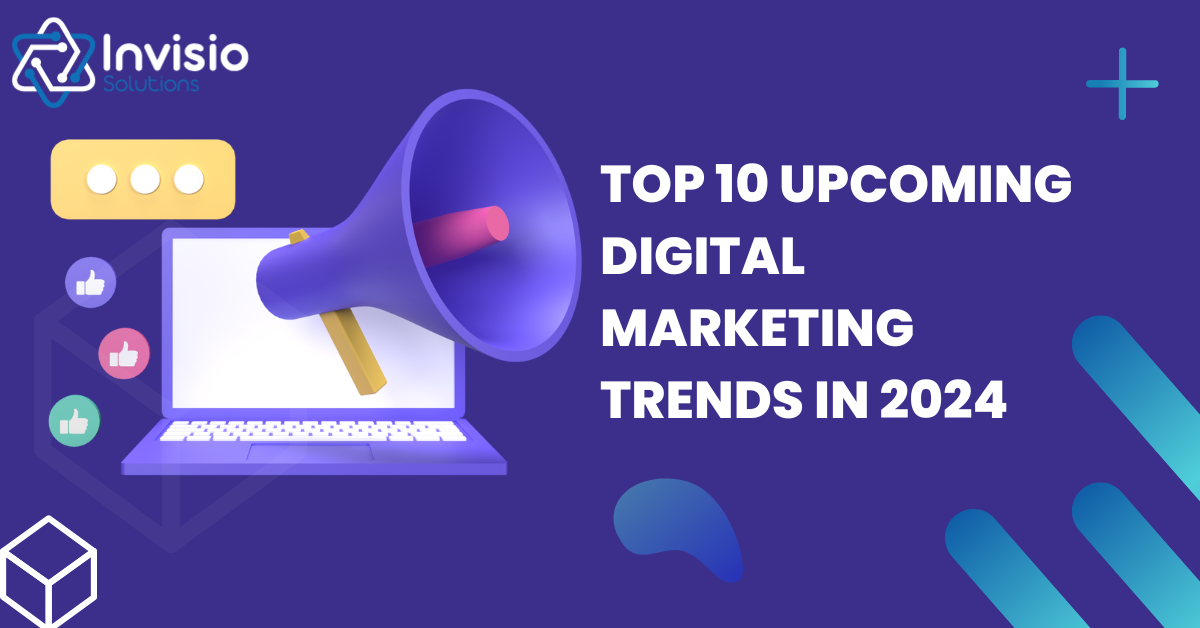


Welcome to the Future of Digital Marketing: Unveiling the Top Trends of 2024! Get ready to embark on an exciting journey as we reveal the most influential trends shaping the digital marketing landscape this year. Prepare to navigate through the ever-evolving realms of consumer engagement and technological advancements, ensuring you stay ahead of the curve in the transformative world of digital marketing.
In the ever-evolving landscape of digital marketing, change is not just constant—it’s rapid. A prime example of this dynamism is the remarkable surge of artificial intelligence (AI) witnessed in 2023, a trend set to continue reshaping all facets of marketing in 2024.
However, marketing isn’t solely influenced by technological advancements; it’s also deeply impacted by shifting consumer behaviors and external factors. Despite predictions of modest global growth and a cooling inflation rate by the OECD, consumer frugality remains prevalent. Moreover, a growing emphasis on corporate social responsibility means consumers are gravitating towards brands that prioritize societal impact over mere profit margins.
Successfully navigating the digital marketing terrain in 2024 demands foresight and adaptability. By staying abreast of emerging trends, businesses can proactively plan, strategize, and outpace their competitors.
In this article, we’ll delve into the pivotal digital marketing trends anticipated for 2024, drawing insights from our esteemed global experts at the Digital Marketing Institute:
In 2024, AI’s profound impact on digital marketing is undeniable. By offering unparalleled insights into consumer behavior and search patterns, alongside its ability to augment other marketing strategies, AI emerges as a formidable force. Businesses are increasingly embracing AI to delve deeper into customer preferences and deliver personalized experiences. This surge in AI adoption comes as no surprise, given the exponential growth projected for the artificial intelligence sector in India. With an expected annual growth rate of 19.99%, reaching an estimated $14.72 billion by 2030, these statistics underscore AI’s pivotal role in amplifying the effectiveness and efficiency of digital marketing endeavors.
In the fierce battle for customer attention, paid advertising emerges as a strategic avenue for companies to target their core audience with precision. The allure of the pay-per-click (PPC) model lies in its ability to grant marketers full control over their spending, allowing them to adhere to a predetermined budget.
At the forefront of this domain stands Google, commanding a dominant position. With a staggering worldwide revenue of $76.7 billion in Q3 2023, $59.6 billion of which stemmed from Google advertising alone, the numbers speak volumes. This marked a notable 9.5% year-on-year increase, underscoring the enduring demand for paid ads.
As we venture into 2024, this growth trajectory shows no signs of waning. However, amidst this flourishing landscape, the integration of AI promises to usher in transformative developments worth considering.
In the realm of Google Ads
AI emerges as a valuable assistant poised to enhance campaign efficiency. However, as Google introduces further generative AI tools into its platform in 2024, it’s imperative to approach with a hint of skepticism. While these advancements can offer assistance, there’s a risk of inherent biases creeping into algorithms and ad layouts, given Google Ads’ revenue-driven nature.
As Cathal Melinn, Digital Marketing Director and Ecommerce specialist, aptly points out, Google’s shift towards AI gradually diminishes marketers’ control over campaign management tasks. This reliance on AI may restrict visibility and performance control, leading to over-optimization devoid of contextual nuance and linguistic finesse that humans inherently possess.
In essence, it’s crucial to view AI as an invaluable ally in your marketing strategy, rather than relying solely on its capabilities. While Google Ads provides optimization suggestions through its interface, it’s essential to critically evaluate these recommendations. Remember, Google Ads is designed to drive certain actions, but prioritize actions that align with your goals and objectives for optimal outcomes.
Avoid on-the-spot pressure
When it comes to Google Ad campaigns, it’s vital to maintain independence and rely on your own data-driven insights. Despite your expertise in PPC and search marketing, resist the urge to blindly adhere to Google’s suggestions.
In recent years, Google representatives have been reaching out to accounts, advocating changes to ad campaigns. However, their approach has become more assertive, often pressuring marketers to alter their strategies or adopt specific features. In such situations, Cathal Melinn advises against making impulsive decisions.
Instead, take the time to thoroughly assess the proposed changes and their potential impact on your campaign’s performance. Trust in your expertise and rely on data-backed judgment to ensure that any adjustments align with your overarching goals and objectives.
Native Advertising: Enhancing User Experience
Native advertising seamlessly integrates branded content into the user’s online journey, minimizing intrusion and maximizing engagement. Through sponsored articles, videos, or social media posts, businesses provide valuable information or entertainment that seamlessly blends with the user’s browsing experience.
Influencer Marketing: Harnessing Social Influence
Influencer marketing capitalizes on the popularity and credibility of social media influencers to endorse products or services, enabling businesses to connect with a highly targeted and receptive audience. By leveraging the influencer’s authority and reach, brands can effectively enhance brand visibility and credibility among their desired demographic.
The relentless surge toward mobile-first marketing shows no signs of slowing down in 2024. With a significant portion of consumers relying on mobile devices for internet access, businesses must prioritize optimizing their digital presence for mobile users. This involves implementing responsive website designs that seamlessly adjust to different screen sizes, crafting email campaigns tailored for mobile viewing, and considering mobile app development where applicable.
By adopting a mobile-first approach, businesses can elevate user experiences and effectively connect with their target audience, aligning with shifting consumer behaviors. As the digital marketing landscape evolves, businesses that adeptly navigate these trends will position themselves for success in the fiercely competitive and ever-changing digital realm of 2024.
Additionally, the ascent of voice search and smart devices heralds both new opportunities and challenges for digital marketers. With an increasing number of individuals utilizing voice assistants such as Siri, Alexa, and Google Assistant, businesses must prioritize optimizing their online content for voice search queries. This entails rethinking keyword strategies to align with conversational and long-tail keywords, marking a fundamental shift in approach to cater to evolving user behaviors in the digital landscape.
Harnessing the Power of Smart Devices in Marketing
In addition, the surging adoption of smart devices such as smart speakers, smart TVs, and wearable technology offers fresh avenues for engaging with consumers. Businesses can capitalize on these devices to deliver precisely targeted advertisements, personalized recommendations, and immersive interactive experiences. However, achieving success in this realm requires ensuring seamless integration of marketing efforts across various devices and platforms, thereby maximizing the reach and impact of marketing campaigns.
Interactive content, including quizzes, polls, and augmented reality experiences, is becoming increasingly popular in digital marketing. This form of content not only captures users’ attention but also yields valuable insights for personalizing future marketing strategies. By encouraging active participation, interactive content fosters deeper engagement with audiences, driving higher levels of interaction and brand affinity. Additionally, the data generated from user interactions can inform targeted marketing campaigns, allowing businesses to tailor content and offers to individual preferences and behaviors. As interactive content continues to evolve, its ability to enhance user experiences and deliver measurable results makes it an indispensable tool for modern marketers seeking to connect with their audience in meaningful ways.
As the digital landscape evolves, data privacy and security are gaining paramount importance. Consumers are increasingly vigilant about their data rights, necessitating businesses to prioritize robust data protection measures. It is imperative for businesses to ensure that their marketing practices adhere to stringent data privacy laws and regulations. This includes obtaining explicit consent from users before collecting any personal data and implementing stringent security protocols to safeguard sensitive information.
In today’s hyper-connected world, trust is a crucial currency. By demonstrating a steadfast commitment to data privacy and security, businesses can instill confidence in their customers and build lasting relationships. Clear and transparent communication about data protection measures is essential to reassure customers about the safety of their personal information. Moreover, businesses should regularly update their privacy policies and practices to stay aligned with evolving regulatory requirements and industry best practices. Ultimately, by prioritizing data privacy and security, businesses can not only mitigate risks but also differentiate themselves as trustworthy and responsible stewards of customer data in an increasingly digital world.
Progressive Web Apps (PWAs) are revolutionizing digital marketing trends in 2024, particularly in the mobile arena. Offering an app-like experience directly within a web browser, PWAs significantly enhance user engagement, a critical factor as mobile Internet usage continues to soar. Businesses are increasingly embracing PWAs to deliver a seamless, responsive, and fast mobile experience to their audience. Notably, PWAs are lauded for their swift loading times and the ability to function offline, enhancing user-friendliness.
In India, numerous companies have successfully integrated PWAs into their digital strategies. For instance, Flipkart’s PWA rollout resulted in a remarkable uptick in user engagement and time spent on the site, showcasing the tangible benefits of PWAs in improving the mobile user experience. This exemplifies how PWAs contribute to heightened customer satisfaction and drive business growth by providing an optimized mobile browsing experience that rivals traditional native applications.
In 2024, social commerce is poised to reshape consumer interactions with products and services, ushering in a new era of seamless shopping experiences. Social media platforms are set to deepen their integration with eCommerce functionalities, allowing users to effortlessly make purchases without leaving their preferred social apps. This shift isn’t just about convenience for consumers; it presents a significant opportunity for businesses to expand their reach and drive sales.
The rise of social commerce offers businesses a chance to tap into untapped customer bases and elevate their overall sales performance. By recognizing the potential of social commerce and strategically harnessing its capabilities, businesses can position themselves at the forefront of the digital marketplace. Embracing this trend entails more than just adapting to new technologies; it requires a comprehensive understanding of consumer behavior and preferences in the digital realm. Ultimately, businesses that embrace social commerce and leverage it effectively will stand to benefit from increased brand visibility, enhanced customer engagement, and sustainable growth in an ever-evolving digital landscape.
In 2024, marketers are gearing up for both exhilarating opportunities and formidable challenges. The pervasive influence of AI is fundamentally reshaping consumer behavior, purchasing patterns, and organizational operations across industries.
Insights gleaned from conversations with industry experts underscore a crucial imperative: marketers must wholeheartedly embrace AI to excel in their roles. Even if AI hasn’t yet directly impacted your responsibilities, its significance will only continue to grow in the future. Hence, it’s imperative to proactively acquaint yourself with AI technologies and begin integrating them into your strategies. Failure to do so risks lagging behind in an increasingly AI-driven landscape.
Think about which trends matter to you and focus on what you can take advantage of in 2024.